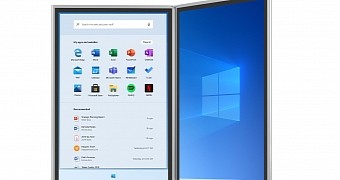Windows 10X is Microsoft’s ambitious operating system supposed to power the dual-screen push in the PC market, and after being announced with much fanfare in the fall of 2019, this new product was supposed to go live this year on the very first models using this new form factor.
However, this didn’t happen, and it’s believed it was all caused by various problems that Microsoft itself came across during the development phase.
Microsoft itself confirmed earlier this year that the Windows 10X plans changed, so instead of bringing this operating system to dual-screen devices, the priority right now is to get it ready for single-screen experiences. What this means is that Windows 10X will first ship on traditional laptops and only then on dual-screen computers, with people familiar with the matter explaining that the whole thing would get to go-ahead at some point in 2022.
“With Windows 10X, we designed for flexibility, and that flexibility has enabled us to pivot our focus toward single-screen Windows 10X devices that leverage the power of the cloud to help our customers work, learn and play in new ways. These single-screen devices will be the first expression of Windows 10X that we deliver to our customers, and we will continue to look for the right moment, in conjunction with our OEM partners, to bring dual-screen devices to market,” Panos Panay, Chief Product Officer, Windows + Devices, announced in May this year.
And according to a new report, we’re getting closer to the moment Windows 10X would finally be ready to go live.
The RTM build is now reportedly set for December, and the plan right now is to launch in the spring of 2021 on the first devices. As said, only single-screen experiences would be powered at first, and a year later the OS could expand to dual-screen models too.
2022 is also expected to bring another important addition to the Windows 10X feature arsenal: support for Win32 apps that would run on cloud power thanks to a new product called Microsoft Cloud PC.
Windows 10X is positioned as a direct rival to Chrome OS, the Google operating system powering Chromebooks, so in many ways, Microsoft wants to slow down the adoption of its rival platform and instead direct more customers to Windows.
But Windows 10X comes with one big advantage in the fight against Chrome OS, and this is the aforementioned cloud-powered Win32 app support. By providing access to legacy Windows programs, Windows 10X can easily address a potential app gap, thus making sure customers can use the device just the way they want.
Windows 10X is unlikely to be installed on high-end devices, with Microsoft right now planning to target the low and mid-range PC industry. This is because these are the markets where Chromebooks are rapidly gaining ground, so in the long term, Microsoft’s plan is pretty obvious.
Windows 10X could also land on ARM PCs, and again, this strategy is built to counter the potential growth that a rival is experiencing in this market. Apple has started building its very own chips, and the first devices running on Apple Silicon are already available for purchase. So Windows 10X is overall Microsoft’s response to the growth of devices built by competitors, especially in the education sector.
Windows 10X won’t be offered by Microsoft to other users, which means you can’t just get this OS version and install it on your computer. Instead, it will come pre-loaded on these new PCs, a strategy that its competitors have also embraced for their devices.

 14 DAY TRIAL //
14 DAY TRIAL //